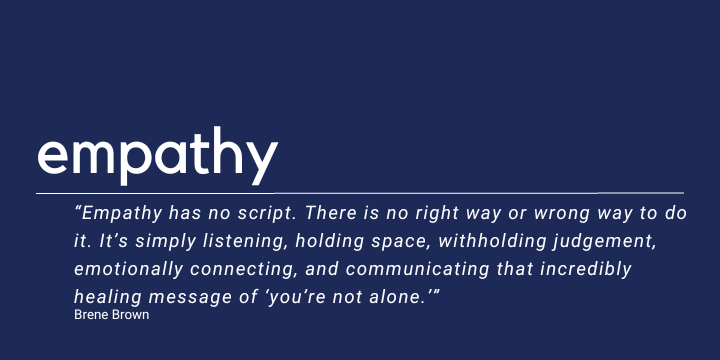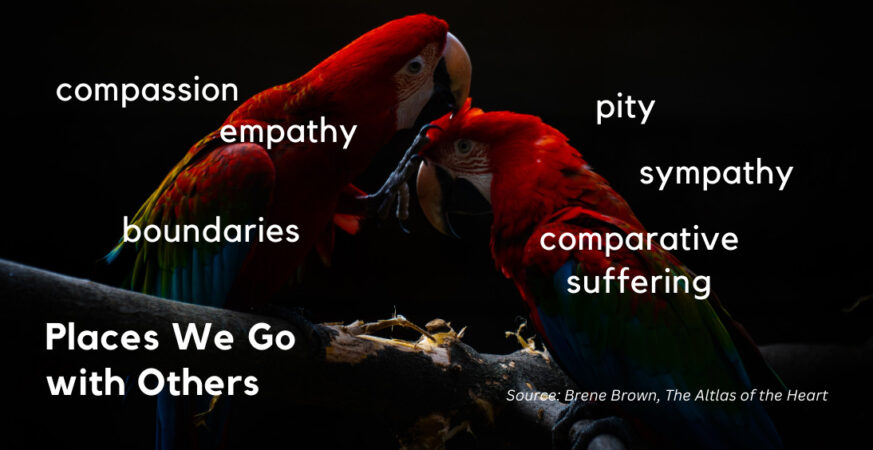How to develop empathy | Mentoring under Construction
![MuC MeetUP FB Cover 2 [Belinda Fewings via unsplash]](https://michaelkimmig.eu/wp-content/uploads/2023/11/2023-09-04-MeetUP-FB-Cover-2-Belinda-Fewings-via-unsplash-800x450.jpg)
The content of this blog post has been created in the context of Mentoring under Construction. Mentoring under Construction is a community for mentoring practitioners within the European Solidarity Corps programme.
When it comes to developing mentoring competence, there are a lot of (micro-)skills like listening or asking questions that are easy to acquire and master. Other abilities are more complex in nature and take more time, effort and consistency to develop. Empathy is one of them. In our Mentoring under Construction MeetUP on empathy we explored; how we understand empathy in the context of mentoring and how we can develop empathy.
What is empathy to you
“Empathy, I would say is presence. Pure presence to what is alive in a person at this moment.”
Marshall Rosenberg
First, let’s take a look at the images and choose an image that resembles empathy for you.
![Empathy [collage unsplash]](https://michaelkimmig.eu/wp-content/uploads/2023/11/Empathy-collage-unsplash-873x450.jpg)
Many people choose glasses for adopting the perspective of another person. Changing glasses enables to see the situation of the other person with their eyes or from their perspective. Other people might choose shoes: Walking in the shoes of another person goes beyond changing the perspective. It means also being able to imagine how it feels to walk in another person’s shoes. Other images, e.g. people sitting close to one another hands that are reaching out stand for holding space for another person. This closeness refers to being there for the other person, being able to offer support and listen.
While perspective taking and holding space for another person are undoubtedly characteristics of empathy, the ability of walking in another persons shoes is often questioned. So, let’s check what research says on empathy.
What is empathy

empathy, from Greek empatheia (em- ‘in’ + pathos ‘feeling’), is the ability to understand and appreciate another person’s feelings, experience, etc. Oxford English Dictionary
According to Theresa Wiseman (1996) empathy has four attributes:
- Perspective taking – the ability to see the world as others see it: What is that experience like for you? What does this experience mean to you?
- Staying out of judgement – the ability to just listen and to leave out judging the other person,
- Recognizing emotion – the ability to connect with your own feelings, which helps to identify and connect with what the other person might be feeling. This requires checking-in and clarifying what you are hearing and asking questions.
- Communicating our understanding of the emotion – the ability to name and communicate your own feelings that resonate with the other person, which might be sometimes elaborate and detailed, and sometimes simply: “That must be hard. I get that.”
A person who is showing empathy does not have to share the experience of another person. Brené Brown points this out as “a dangerous myth” about empathy: “Empathy is not relating to an experience, it’s connecting to what someone is feeling about an experience.” (Brené Brown, The Atlas of the Heart) As long as you know joy, hurt, heartbreak, shame, grief, love, etc. you are able to connect with the feelings of another person.

Brené Brown summerizes these four charecteristics: “Empathy has no script. There is no right way or wrong way to do it. It’s simply listening, holding space, withholding judgement, emotionally connecting, and communicating that incredibly healing message of ‘you’re not alone.’” (Brené Brown, The Atlas of the Heart)
Empathy is a choice, and as Brené Brown says, a vulnerable choice. It is not pushing away emotion because it’s uncomfortable; it means feeling it and moving through it. Empathy can be strengthened with practice and mindfulness.
Compassion and empathy: Brené Brown on empathy
“Compassion is a daily practice and empathy is a skill set that is one of the most powerful tools of compassion.”
Brené Brown
Brené Brown starts her chapter „Places We Go with Others” (The Atlas of the Heart) with a general question: What’s the most effective way to be in connection with and in service to someone who is struggling, without taking on their issues as our own? – According to her research that’s compassion and empathy.
Brené Brown’s research showed that compassion and empathy are quite close to one another: Compassion can be understood as a daily practice of recognizing, accepting and responding to the suffering and needs of another person through relational understanding and action. “Compassion includes action. It’s not just feeling, it’s doing.” Compassion is not jumping into action and trying to make something better or fix the problem. It’s a practice of holding the space for another person, to literally sit with him/her in the dark.
Cognitive and affective empathy
„Empathy … is an emotional skill set that allows us to understand what someone is experiencing and to reflect back that understanding.”
Brené Brown
Empathy has two elements: cognitive empathy and affective empathy:
- Cognitive empathy is about taking the perspective of another person. It is the ability to recognize and understand the emotions of another person.
- Affective empathy is about sharing the experience. It is the ability to connect with one’s own feelings that relate to another person’s experience.
In that sense, empathy is not „walking in the shoes of another person”, but walking in your own shoes and connecting with a feeling that relates to the other person. It is about understanding what the other person is feeling. If the other person is feeling lost, empathy is about reaching back to our own experience with being lost, which allows us to connect with the other persons experience and understand him/her better.
“The most effective approach to meaningful connection combines compassion with a specific type of empathy called cognitive empathy.” Brené Brown
Activity: A language of feelings
If empathy is about connecting with one’s own feelings, it is important to extend our vocabulary of feelings. We need to develop our language of feelings. Here’s an invitation for a small exercise:
Write down (in your mother tongue) all emotions/feelings you felt during the last week
After that, please count:
- How many different feelings were there? Write down the number!
- How many of them are positive? Write down the number!
Reflection
- How many different feelings did you write down? 5? 10? 15? more?
- How broad is our spectrum of feelings? And how many of them where positive ones?
If you want you can go now to the website of New York Center for Nonviolent Communication and compare your list with theirs… „dazzled”, „enthralled”, „intrigued”, „delighted”, „fulfilled”, … are those on your list? And why is it important to have a distinct language of feelings?
What empathy is not
Instead of showing empathy people might respond with pity (“Oh, you poor thing”) or sympathy (“I feel so sorry for you”). The subtext of pity or sympathy is distance. Rather than fostering connection (“I get it, I feel with you, and I’ve been there”) they both drive disconnection. (This short animation shows the difference between empathy and sympathy)

One last insight: Clear boundaries help
One key insight of Brené Brown’s research is about boundaries: clear boundaries and empathy go hand in hand.
“Boundaries are a prerequisite for compassion and empathy. We can’t connect with someone unless we’re clear about where we end and they begin. If there’s no autonomy between people, then there’s no compassion or empathy, just enmeshment.”
Brené Brown
Empathy in mentoring practise
Why is empathy important in mentoring
- Empathy is important because it allows mentors to build a strong relationship with their volunteers.
- Empathy helps create a safe and supportive space where volunteers feel comfortable sharing their thoughts and feelings.
- Empathy helps volunteers to overcome challenges, achieve their goals, and grow as a person.
We finished our exploration on empathy with a discussion:
- How does your volunteer express his/her feelings?
- How do you establish a common language for feelings together with your volunteer?
- How can we (as mentors) extend our own vocabulary of feelings?
Check out the notes on this padlet
An activity in self-empathy (by M. Rosenberg)
“Self-empathy in #NVC means checking in with your own feelings and needs.”
Marshal Rosenberg
Marshal Rosenberg suggest four questions that help practice self-empathy and lead to more clarity and empathy in one-on-one conversations:
- What do I think?
- What do I feel?
- What is now important to me?
- What in this context would I like to do?
How to develop empathy
There are many ways to develop empathy. Some helpful strategies include:
- Cultivating curiosity: Ask questions and genuinely want to understand your volunteer’s experiences.
- Stepping outside of your comfort zone: Put yourself in situations that challenge you to see the world from a different perspective.
- Receiving feedback: Ask your volunteer and other people how you can be more empathetic.
- Examining your biases: Be aware of your own biases and how they might affect your interactions with the volunteer.
- Practising active listening: Listen attentively to your volunteer and reflect back what you hear to show that you understand.
- Being non-judgmental: Avoid judging your volunteer’s thoughts, feelings, or experiences.
- Being supportive: Offer your volunteer support and encouragement without trying to fix their problems for them.
Developing empathy takes time and practice, but it is an essential skill for any mentor.
Recommended Resources
Brené Brown (2021): Places We Go with Others, The Atlas of the Heart, p.114-131
Brené Brown on Empathy: youtube
Communication Skills: Empathetic Listening – Inside Out, 2015, youtube
The Mentoring under Construction Community is open for everyone who is interested in raising the quality in mentoring within European Solidarity Corps programme (and beyond): mentors, project managers/organisers, coordinators of volunteers, facilitators of learning, authors and trainers, and members of National Agencies and SALTO Resource Centres.
Mentoring under Construction | SALTO
Mentoring under Construction Community | Facebook



![MuC Mentoring Competence Framework [title slide]](https://michaelkimmig.eu/wp-content/uploads/2024/12/MuC-Framework-title-520x245.jpg)